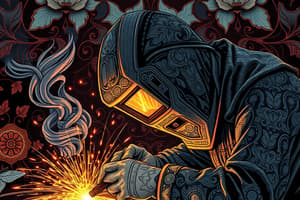Podcast
Questions and Answers
Thermostat calls for _____
Thermostat calls for _____
heat
What happens when the gas valve opens?
What happens when the gas valve opens?
Flame lights
Furnace gets ______
Furnace gets ______
hot
_____ switch closes
_____ switch closes
_____ runs
_____ runs
Thermostat calls for _____ (newer inducement)
Thermostat calls for _____ (newer inducement)
_________ fan starts
_________ fan starts
__________ switch makes
__________ switch makes
________ activates (spark, hot surface)
________ activates (spark, hot surface)
Gas valve (opens/closes) -- ______ lights
Gas valve (opens/closes) -- ______ lights
_____ has 3 seconds to verify
_____ has 3 seconds to verify
Fan starts due to ______ _______ time
Fan starts due to ______ _______ time
The gas valve closes and flame goes off when the thermostat is satisfied.
The gas valve closes and flame goes off when the thermostat is satisfied.
Limit switch powers (on/off) the system if the temperature around the heat ___________ gets too high.
Limit switch powers (on/off) the system if the temperature around the heat ___________ gets too high.
Which can cause the limit switch to trip?
Which can cause the limit switch to trip?
When the furnace is off, is the pilot lit?
When the furnace is off, is the pilot lit?
Define flame rectification.
Define flame rectification.
A thermocouple generates how much electricity?
A thermocouple generates how much electricity?
HSI's are required to have a flame sensor.
HSI's are required to have a flame sensor.
What are the two types of ignitions that use pilots to ignite the burners?
What are the two types of ignitions that use pilots to ignite the burners?
Which type of ignition uses a high resistance heating element to ignite the burners?
Which type of ignition uses a high resistance heating element to ignite the burners?
What typically happens when changing a furnace from natural gas to LP?
What typically happens when changing a furnace from natural gas to LP?
Study Notes
Gas Furnace Sequence of Operation
- Older gas furnaces use a pilot light and follow a specific sequence for starting and heating.
- Newer gas furnaces utilize an inducer fan and have a more complex starting procedure to enhance efficiency and safety.
- Important components mentioned include the fan switch, gas valve, thermocouple, and limit switch.
Safety Mechanisms
- Limit switches turn off the system when temperatures around the heat exchanger exceed safe limits to prevent gas flow.
- Roll-out switches monitor flame roll-out situations, noting potential misalignment issues causing unsafe conditions.
- Blocked-vent switches shut down operation in the event of backdraft conditions, crucial for safety.
Ignition Systems
- Intermittent pilot ignition systems vary from traditional pilot systems, with no pilot flame present when the system is inactive.
- Direct spark ignition does not use a pilot and ignites gas directly; offers lower maintenance needs due to simpler design.
- Hot surface igniters (HSI) utilize a heating element to ignite gas, creating a glow that initiates combustion.
Efficiency Ratings
- Annual Fuel Utilization Efficiency (AFUE) measures how effectively a furnace converts fuel into heat, rated in BTU.
- Different efficiency levels (60%, 80%, 90%+) indicate variations in design components, heat exchangers, and combustion processes.
Troubleshooting & Maintenance
- Common issues include a failed pilot light, blocked venting, or malfunctioning pressure switches which could necessitate investigation and repair.
- Regular checks on wiring, gas pressure, and system components ensure safe operation and efficient performance.
- When transitioning between fuel types, like natural gas to LP gas, specific changes to the gas manifold and pressure regulators are essential.
Combustion Principles
- Combustion involves fuel chemicals and oxygen rapidly combining, often resulting in heat and byproducts like carbon dioxide.
- Proper combustion requires precise gas pressure settings: 3.5" WC for natural gas, and 10-11" WC for LP gas.
Electrical Systems
- Flame rectification is a critical safety feature that utilizes current flow to verify the presence of a flame.
- Solenoid valves control gas flow based on signals from safety devices, and thermocouples sense flame presence to prevent gas leaks.
Component Functions
- Spuds in gas manifolds regulate gas flow to burners and are essential for maintaining proper combustion levels.
- The use of high-limit switches prevents overheating in the system, while roll-out switches protect against flame roll-out scenarios.
- The gas manifold supplies fuel to multiple burners, ensuring an efficient heating process.
Pilot Types and Flame Detection
- Standing pilot systems continuously burn gas to maintain ignition; intermittent pilots only ignite when needed.
- Pilot systems (both standing and intermittent) rely on thermoelectric effects to maintain gas flow and ensure safety.
Important Terms and Measurements
- Inches of Water Column (WC) is the standard measurement for gas pressure in HVAC systems.
- Changes in altitude affect furnace performance, often requiring adjustments in orifice size and gas mixture for optimal combustion efficiency.
Electrical and Mechanical Interactions
- High resistance heating elements in HSIs require significant voltage yet produce little electrical noise compared to DSI systems.
- Understanding system wiring, including the role of sense terminals and electrical resistance in various ignition systems, enhances troubleshooting effectiveness.
Studying That Suits You
Use AI to generate personalized quizzes and flashcards to suit your learning preferences.
Description
Explore the operation and safety mechanisms involved in gas furnaces. This quiz covers pivotal components, ignition systems, and essential safety measures that ensure efficient functioning. Whether it's about older pilot light models or modern ignition systems, test your knowledge here.




